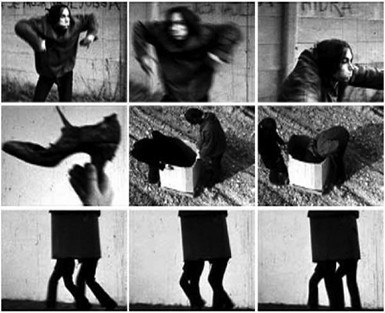19th Nervous Breakdown—so named after the Rolling Stones song that makes up its sound track—is a short film made by the Slovene OHO Group, a collective that between in the late 1960s pioneered in Slovenia (and Yugoslavia more broadly) new modes of avant-garde artistic practice. The film depicts what appears to be (though may not have been) an impromptu happening.[1] In it, Marko Pogačnik, one of OHO’s two founding members, along with his wife, Marika, perform a series of playful actions, such as drawing and writing on a concrete wall that sits in the middle of a field, running and dancing in the field, and, finally, after finding an empty cardboard box, making it “come alive” by walking off screen with their legs sticking out from under it.
Shot by Naško Križnar (b. 1943), the amateur filmmaker who made most of OHO’s short films, the film is notable for the feelings of spontaneity, dynamism, and joy that it conveys, partly through the music and partly through the shaky immediacy of footage shot with a handheld 8 mm camera. It also captures the experimental approach to art-making and the philosophical ideas that OHO members were also working out at the time in other media through the concept of “reism”—a way of seeing the world in which objects are equivalent to humans in importance and are not seen only for their utilitarian value. The shoe that Pogačnik draws in the film and then names “Ana” is an allusion to the 1966 “OHO Manifesto,” which used a lengthy verbal description of a shoe—normally, a literally downtrodden object—to show the failure of language to encapsulate the complexity even of everyday things and to defamiliarize the reader’s perception of a shoe. Similarly, seeing the world through reistic “free vision,” the film shows the artists find a creatively non-utilitarian use for a large cardboard box, with which they merge temporarily into a single, strange creature. The film’s most original cinematic contribution may be a sequence in which, after filming the walking box from the outside, Križnar gets under it with his friends, as if to see the world through its “eyes” in a truly reist manner. This technique reappears in several later films that show OHO performances in Ljubljana and is related to the “winking” objects in Dok. Film (also screened in the program), which also make viewers aware of their own habits of perception when it comes to the world of objects around them.
Shot by Križnar in a large empty field in his and Pogačnik’s native town of Kranj, the film seems to derive some of its joie de vivre from the freedom that comes from acting as one pleases in a large, empty space. In 1968 and 1969, other OHO members would intermittently make a conscious effort to bring this sense of freedom, play, and spontaneity into the city by staging a series of performances in Ljubljana’s central Zvezda Park, but these efforts were short-lived. When OHO’s most complicated film, White People, was shot in 1969, it took the members of the group back into nature, which at that point seems to have become a refuge from the futile hubbub of the city (which included political protests whose demands went unanswered) and the only place where the group could create a fantasy of a different kind of life. — Ksenya Gurshtein
With thanks to Naško Križnar and Igor Španjol and the Museum of Modern Art, Ljubljana, for help in making a screening of this film possible in Washington.

